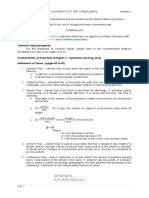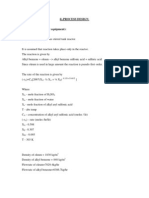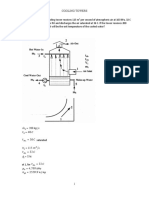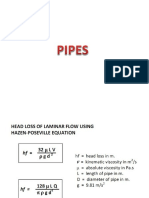HW10 Solution
Uploaded by
Muath AlShehriHW10 Solution
Uploaded by
Muath AlShehriCrowe/Engineering Fluid Mechanics 10.27: PROBLEM DEFINITION Situation: Oil ows through a smooth pipe. L = 12 m, z1 = 1 m, z2 = 2 m. V = 1.2 m / s, D = 5 cm.
Sketch:
Find: Flow direction. Resistance coecient. Nature of ow (laminar or turbulent). Viscosity of oil (N s / m2 ). Properties: S = 0.8. SOLUTION Based on the deection on the manometer, the piezometric head (and HGL) on the right side of the pipe is larger than that on the left side. Thus, the ow is downward (from right to left). Energy principle V2 V2 p1 p2 + 2 2 + z2 = + 1 1 + z1 + hL 2g 2g Assume 1 V1 = 2 V2 . Let z2 z1 = 1 m . Also the head loss is given by the Darcy Weisbach equation: hf = f (L/D)V 2 /(2g). The energy principle becomes L V2 p2 p1 = (1 m) + f oil D 2g Manometer equation p2 + (2 m) oil + (0.1 m) oil (0.1 m) Hg (1 m) oil = p1 Algebra gives (1)
38
Crowe/Engineering Fluid Mechanics Hg p2 p1 = (2 m) (0.1 m) + (0.1 m) + (1 m) oil oil SHg = (1 m) + (0.1 m) 1 Soil 13.6 1 = (1 m) + (0.1 m) 0.8 p2 p1 = 0.6 m oil Substituting Eq. (2) into (1) gives (0.6 m) = (1 m) + f or f = 1.6 = 1.6 D 2g L V2 0.05 m 2 9.81 m / s2 12 m (1.2 m / s)2 L V2 D 2g
(2)
f = 0.0908 Since the resistance coecient is now known, this value can be used to nd viscosity. To perform this calculation, assume the ow is laminar. 64 Re 64 0.0908 = V D or 0.0908V D = 64 0.0908 (0.8 1000) 1.2 0.05 = 64 = 0.068 N s/m2 f = Now, check Reynolds number to see if laminar ow assumption is valid V D 1.2 0.05 (0.8 1000) = 0.068 = 706
Re =
Thus, ow is laminar.
39
Crowe/Engineering Fluid Mechanics 10.49: PROBLEM DEFINITION Situation: Water is pumped from a reservoir to a tank. D = 10 cm, L = 90 m. Q = 0.03 m3 / s, = 0.9. pB = 70 kPa, pA = 0 kPa. Sketch:
Find: Power to operate the pump. Assumptions: Assume the entrance is smooth. Properties: Water (15 C) Table A.5: = 1.14 106 m2 /s. Pipe roughness, Table 10.4 (EFM9e), ks = 0.046 mm. Loss Coecients, Table 10.5 (EFM9e), Ke = 0.03, KE = 1. SOLUTION Flow rate equation V 0.03 m3 / s Q = = A (/4)D2 0.03 m3 / s = (/4)(0.1 m)2 = 3.82 m/s
Then Re = 3.82 m / s (0.1 m) = 3.35 105 1.14 106 m2 / s
ks = 4.6 104 D Resistance coecient (from Moody diagram) f = 0.0165 Then f L 90 m = 0.0165 = 14.85 D 0.1 m 70
Crowe/Engineering Fluid Mechanics Energy equation (from water surface A to water surface B) V2 V2 p2 pA hL + A A + zA + hp = + 2 2 + z2 + 2g 2g 70 103 Pa L 0 + 0 + 0 + hp = + 0 + Ke + KE + f 3 9800 N / m D Thus (3.82 m / s)2 = 7.14 m +(0.03 + 1 + 14.85) 19.62 m / s2 = 18.95 m
V2 2g
hp
Power equation Qhp 0.03 m3 / s 9800 N / m3 18.95 m = 0.9 Nm = 6190.3 s = P = 6190 W
P =
71
Crowe/Engineering Fluid Mechanics 10.56: PROBLEM DEFINITION Situation: A uid ows through a galvanized iron pipe. D = 8 cm . Pipe slope is 1 Horizontal to 10 Vertical. Sketch:
Find: Flow rate. Properties: From Table 10.4 ks = 0.15 mm. = 800 kg / m3 , = 106 m2 / s . SOLUTION Energy equation V12 p1 + z1 + 1 2g 150000 Pa V12 +0 + 800 kg / m3 9.81 m / s2 2g hf ((D3/2 )/()) (2ghf /L)1/2 V22 p2 + 2 + z2 + hf = 2g 120000 Pa V22 = + 3 m +hf + 800 kg / m3 9.81 m / s2 2g = 0.823 m = ((0.08)3/2 /106 ) (2 9.81 0.823/30.14)1/2 = 1.66 104
Relative roughness 1.5 104 ks = = 1.9 103 D 0.08 Resistance coecient. From Fig. 10-8 f = 0.025. Then hf = f Solving for V L V2 D 2g
83
Crowe/Engineering Fluid Mechanics
= =
hf f
D L
2g 0.08 m 30.14 m 2 9.81 m / s2 = 1.312 m/s
0.823 m 0.025
Q = VA = 1.312 m / s (/4) (0.08 m)2 = 6.59 103 m3 / s Q = 6.59 103 m3 / s
84
Crowe/Engineering Fluid Mechanics 10.66: PROBLEM DEFINITION Situation: Oil is pumped from a lower reservoir to an upper reservoir through a steel pipe. D = 30 cm, Q = 0.20 m3 / s. z1 = 100 m, z2 = 112 m, L = 150 m. Sketch:
Find: (a) Pump power. (b) Sketch an EGL and HGL. Properties: = 940 kg / m3 , v = 105 m2 / s. From Table 10.4 ks = 0.046 mm PLAN Apply the energy equation between reservoir surfaces . SOLUTION Energy equation p1 V2 V2 p2 + 2 2 + z2 + + 1 1 + z1 + hp = hL 2g 2g V2 L (Ke + f + KE ) 100 + hp = 112 + 2g D 2 L V 0.03 + f + 1 hp = 12 + 2g D Flow rate equation Q A
= =
0.2 m3 / s (/4) (0.30 m)2 = 2.83 m/s V2 = 0.408 m 2g 105
Crowe/Engineering Fluid Mechanics Reynolds number Re = = = ks = D = VD v 2.83 m / s 0.30 m 105 m2 / s 8.5 104 4.6 105 m 0.3 m 1.5 104
Resistance coecient (from the Moody diagram, Fig. 10.8) f = 0.019 Then hp = 12 m +0.408 m(0.03 + (0.019 = 16.3 m Power equation 150 m ) + 1.0) 0.3 m
P = Qhp = 0.20 m3 / s (940 kg / m3 9.81 m / s2 ) 16.3 m = 30100 W P = 30.1 kW
HGL EGL
106
Crowe/Engineering Fluid Mechanics 10.95: PROBLEM DEFINITION Situation: Three pipes are connected in parallel LA = 2000 m, DA = 45 cm, fA = 0.012. LB = 600 m, DB = 15 cm, fB = 0.020. LC = 1500 m, DC = 30 cm, fC = 0.015. Sketch:
Find: The pipe having the greatest velocity. SOLUTION hp,A = hf,B = hf,C L V L V2 L V2 f = f =f D 2g A D 2g B D 2g C 2000 m 600 m 1500 m 2 2 0.012 VA = 0.02 VB = 0.015 0.45 m 0.15 m 0.3 m 2 2 2 53.3VA = 80VB = 75VC
2
2 VC
Therefore, VA will have the greatest velocity. Correct choice is (a)
155
You might also like
- Ma2003 Introduction To Thermo-Fluids: H, Between The Water Levels in The Two OpenNo ratings yetMa2003 Introduction To Thermo-Fluids: H, Between The Water Levels in The Two Open5 pages
- Chapter #1 - Basics of Fluid Mechanics and Hydraulics100% (2)Chapter #1 - Basics of Fluid Mechanics and Hydraulics22 pages
- Study The Effect of PH and TDS On The Corrosion Rate of Carbon SteelNo ratings yetStudy The Effect of PH and TDS On The Corrosion Rate of Carbon Steel9 pages
- 5.3 Design of Waste Heat Boiler: (13) : DataNo ratings yet5.3 Design of Waste Heat Boiler: (13) : Data7 pages
- SI Units Hukum Gas Ideal Turbin Efis Power Pressure Tcompress Flow Mdot Vnormal Mol RNo ratings yetSI Units Hukum Gas Ideal Turbin Efis Power Pressure Tcompress Flow Mdot Vnormal Mol R3 pages
- Fluid Mechanics Examples and Answers: July 2016No ratings yetFluid Mechanics Examples and Answers: July 201633 pages
- Fluid Mechanics Rest: Common Liquid PropertiesNo ratings yetFluid Mechanics Rest: Common Liquid Properties13 pages
- Case-1: Subcase-1: C 100 Subcase-2: C 130No ratings yetCase-1: Subcase-1: C 100 Subcase-2: C 1301 page
- Instructions: Read The Problems Carefully To Give Short But Justified Answers. The CompleteNo ratings yetInstructions: Read The Problems Carefully To Give Short But Justified Answers. The Complete2 pages
- Chapter 9-Flow Over Immersed Bodies-Problem SetNo ratings yetChapter 9-Flow Over Immersed Bodies-Problem Set10 pages
- Velocity Ranges (Metcalf & Eddy) Pressurized Pipe Non-Pressurized Pipe Through Gravity 1 - 3 M/s 0.5 - 1 M/s 0.1 - 0.6 M/sNo ratings yetVelocity Ranges (Metcalf & Eddy) Pressurized Pipe Non-Pressurized Pipe Through Gravity 1 - 3 M/s 0.5 - 1 M/s 0.1 - 0.6 M/s4 pages
- Ghanim - Objectives of The Open Channel Flow PracticalNo ratings yetGhanim - Objectives of The Open Channel Flow Practical6 pages
- A Centrifugal Pump Converts The Input Power To Kinetic Energy in The Liquid by Accelerating The Liquid by A Revolving DeviceNo ratings yetA Centrifugal Pump Converts The Input Power To Kinetic Energy in The Liquid by Accelerating The Liquid by A Revolving Device6 pages
- HYDRAULICS LECTURE Fundamentals of Fluid FlowNo ratings yetHYDRAULICS LECTURE Fundamentals of Fluid Flow30 pages
- Evaluation of Hydrocarbon Heat Transfer Fluids: Standard Guide ForNo ratings yetEvaluation of Hydrocarbon Heat Transfer Fluids: Standard Guide For3 pages
- Title: Aim: Apparatus/Materials:: Centre of Gravity To Locate The Centre of Gravity of An Irregular Shaped LaminaNo ratings yetTitle: Aim: Apparatus/Materials:: Centre of Gravity To Locate The Centre of Gravity of An Irregular Shaped Lamina3 pages
- Experiment 1 Potentiometric Titration: Joan Marie Ilagan Joanne Sasondoncillo Ma. Kezia TayagNo ratings yetExperiment 1 Potentiometric Titration: Joan Marie Ilagan Joanne Sasondoncillo Ma. Kezia Tayag11 pages
- Ways of Expressing Concentrations of SolutionNo ratings yetWays of Expressing Concentrations of Solution52 pages
- Board Question Paper: March 2018: Science and Technology - IiNo ratings yetBoard Question Paper: March 2018: Science and Technology - Ii2 pages
- Modul 2 Science Form 1 Chapter 2: Cell As A Unit of Life What Is Cell?No ratings yetModul 2 Science Form 1 Chapter 2: Cell As A Unit of Life What Is Cell?22 pages
- UV Choice of solvent and solvent effectNo ratings yetUV Choice of solvent and solvent effect10 pages
- November 2021 Exam CHMT3041 FINAL Signed - 1647869643No ratings yetNovember 2021 Exam CHMT3041 FINAL Signed - 16478696437 pages
- Buschow KHJ Handbook of Magnetic Materials Volume 06No ratings yetBuschow KHJ Handbook of Magnetic Materials Volume 06608 pages
- Exp. 1 EFFECT OF FLOW RATE IN THE EFFECTIVENESS OF SHELLTUBE HEAT EXCHANGERNo ratings yetExp. 1 EFFECT OF FLOW RATE IN THE EFFECTIVENESS OF SHELLTUBE HEAT EXCHANGER6 pages
- Ma2003 Introduction To Thermo-Fluids: H, Between The Water Levels in The Two OpenMa2003 Introduction To Thermo-Fluids: H, Between The Water Levels in The Two Open
- Chapter #1 - Basics of Fluid Mechanics and HydraulicsChapter #1 - Basics of Fluid Mechanics and Hydraulics
- Study The Effect of PH and TDS On The Corrosion Rate of Carbon SteelStudy The Effect of PH and TDS On The Corrosion Rate of Carbon Steel
- SI Units Hukum Gas Ideal Turbin Efis Power Pressure Tcompress Flow Mdot Vnormal Mol RSI Units Hukum Gas Ideal Turbin Efis Power Pressure Tcompress Flow Mdot Vnormal Mol R
- Instructions: Read The Problems Carefully To Give Short But Justified Answers. The CompleteInstructions: Read The Problems Carefully To Give Short But Justified Answers. The Complete
- Velocity Ranges (Metcalf & Eddy) Pressurized Pipe Non-Pressurized Pipe Through Gravity 1 - 3 M/s 0.5 - 1 M/s 0.1 - 0.6 M/sVelocity Ranges (Metcalf & Eddy) Pressurized Pipe Non-Pressurized Pipe Through Gravity 1 - 3 M/s 0.5 - 1 M/s 0.1 - 0.6 M/s
- Ghanim - Objectives of The Open Channel Flow PracticalGhanim - Objectives of The Open Channel Flow Practical
- A Centrifugal Pump Converts The Input Power To Kinetic Energy in The Liquid by Accelerating The Liquid by A Revolving DeviceA Centrifugal Pump Converts The Input Power To Kinetic Energy in The Liquid by Accelerating The Liquid by A Revolving Device
- Evaluation of Hydrocarbon Heat Transfer Fluids: Standard Guide ForEvaluation of Hydrocarbon Heat Transfer Fluids: Standard Guide For
- Title: Aim: Apparatus/Materials:: Centre of Gravity To Locate The Centre of Gravity of An Irregular Shaped LaminaTitle: Aim: Apparatus/Materials:: Centre of Gravity To Locate The Centre of Gravity of An Irregular Shaped Lamina
- Experiment 1 Potentiometric Titration: Joan Marie Ilagan Joanne Sasondoncillo Ma. Kezia TayagExperiment 1 Potentiometric Titration: Joan Marie Ilagan Joanne Sasondoncillo Ma. Kezia Tayag
- Board Question Paper: March 2018: Science and Technology - IiBoard Question Paper: March 2018: Science and Technology - Ii
- Modul 2 Science Form 1 Chapter 2: Cell As A Unit of Life What Is Cell?Modul 2 Science Form 1 Chapter 2: Cell As A Unit of Life What Is Cell?
- November 2021 Exam CHMT3041 FINAL Signed - 1647869643November 2021 Exam CHMT3041 FINAL Signed - 1647869643
- Buschow KHJ Handbook of Magnetic Materials Volume 06Buschow KHJ Handbook of Magnetic Materials Volume 06
- Exp. 1 EFFECT OF FLOW RATE IN THE EFFECTIVENESS OF SHELLTUBE HEAT EXCHANGERExp. 1 EFFECT OF FLOW RATE IN THE EFFECTIVENESS OF SHELLTUBE HEAT EXCHANGER

























































































